On The Musical Side Of Videogames
At the same time that videogames have entered their pubescent and adolescent years with games like Space Invaders and Pac-Man (which was when I became a teenager myself), another development in the area of the entertainment media came forth, which was the music video. Originally this idea of putting short visual performances that went with the latest in popular radio songs of the late 1970s and early 1980s appeared in the domain of Home Box Office's Video Jukebox intermission feature, but by 1981 a cable TV network called Music Television (MTV) made the music video a more prominent feature as it originally aired nothing but music videos 24 hours a day on the cable systems that carried this network. Apart from this development which helped define the 1980s in general, videogames and music seemed to be very much made for each other, as those who visited the arcades and pizza parlors and bowling alleys that featured videogames in that time period would end up listening to the likes of "My Sharona" by The Knack or "Don't Stand So Close To Me" by The Police while playing their favorite games to it. Whether it's the beat of the song or the lyrics or the theme or something else entirely, a game player can make that song part of the game's own soundtrack in his mind, in effect creating his own kind of "music video" through the marriage of music and computer imagery.
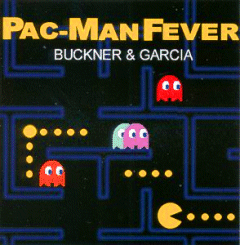 Eventually, videogames would begin to influence music, and then later on do the exact opposite over the years as the merging of the two entertainment mediums slowly fused together. This would begin with what I would call the "national videogame anthem", which would be the song "Pac-Man Fever", developed by two Georgia DJ's Jerry Buckner and Gary Garcia, who were fans of the Pac-Man arcade game. Released in late 1981, "Pac-Man Fever" would become a popular Top 40 radio song for several weeks, inspiring the duo to create a follow-up to the single, which would be the album version of Pac-Man Fever, featuring seven other songs based on other videogames like Asteroids, Berzerk, Centipede, Defender, Donkey Kong, Frogger, and Mousetrap. Unfortunately, the novelty of "Pac-Man Fever" wore off by the end of 1982, and the album would disappear into almost obscurity until the late 1990s, when interest in "retro-gaming" would inspire Buckner and Garcia to create an updated version of the Pac-Man Fever album, which they self-released in 1999.
Eventually, videogames would begin to influence music, and then later on do the exact opposite over the years as the merging of the two entertainment mediums slowly fused together. This would begin with what I would call the "national videogame anthem", which would be the song "Pac-Man Fever", developed by two Georgia DJ's Jerry Buckner and Gary Garcia, who were fans of the Pac-Man arcade game. Released in late 1981, "Pac-Man Fever" would become a popular Top 40 radio song for several weeks, inspiring the duo to create a follow-up to the single, which would be the album version of Pac-Man Fever, featuring seven other songs based on other videogames like Asteroids, Berzerk, Centipede, Defender, Donkey Kong, Frogger, and Mousetrap. Unfortunately, the novelty of "Pac-Man Fever" wore off by the end of 1982, and the album would disappear into almost obscurity until the late 1990s, when interest in "retro-gaming" would inspire Buckner and Garcia to create an updated version of the Pac-Man Fever album, which they self-released in 1999.
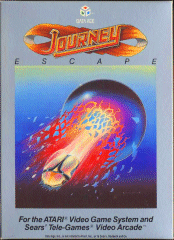
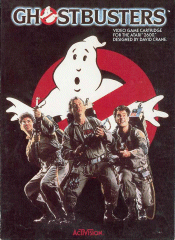 In the meantime, videogame developers began working on translating popular tunes or composing multipart-harmonic music creations of their own to be incorporated into their games, with mixed results. Data Age, a third-party Atari 2600 software developer who sunk their own ship acquiring the license of the music band Journey for their Journey: Escape game, left their own mark with a rather weak musical loop playing the intro section of "Don't Stop Believing" with a graphical animated interpretation of the band's 1981 album cover. Activision a few years later made leaps and bounds with a rendition of Ray Parker Jr.'s theme song to the Ghostbusters movie in the Atari and Commodore personal computer versions of the game, complete with a bouncing ball over the lyrics as the song plays out on the intro screen. However, it was in the Nintendo generation of game systems when musical compositions for videogames really started to come into form, rivaling the output of what regular musicians were putting out for record shops and radio stations. At least until sometime in the 1990s, such musical compositions would only be available for listening by accessing the sound tests, if those games even had such features. Nowadays, game soundtracks can be found on compact disk and sold through various company mail-orders and specialty music shops. And through the miracle of game system emulation, they can also be "ripped" from the games themselves and played back on the computer through special programs, or even burned onto compact disks if you want to create your own soundtrack albums from games.
In the meantime, videogame developers began working on translating popular tunes or composing multipart-harmonic music creations of their own to be incorporated into their games, with mixed results. Data Age, a third-party Atari 2600 software developer who sunk their own ship acquiring the license of the music band Journey for their Journey: Escape game, left their own mark with a rather weak musical loop playing the intro section of "Don't Stop Believing" with a graphical animated interpretation of the band's 1981 album cover. Activision a few years later made leaps and bounds with a rendition of Ray Parker Jr.'s theme song to the Ghostbusters movie in the Atari and Commodore personal computer versions of the game, complete with a bouncing ball over the lyrics as the song plays out on the intro screen. However, it was in the Nintendo generation of game systems when musical compositions for videogames really started to come into form, rivaling the output of what regular musicians were putting out for record shops and radio stations. At least until sometime in the 1990s, such musical compositions would only be available for listening by accessing the sound tests, if those games even had such features. Nowadays, game soundtracks can be found on compact disk and sold through various company mail-orders and specialty music shops. And through the miracle of game system emulation, they can also be "ripped" from the games themselves and played back on the computer through special programs, or even burned onto compact disks if you want to create your own soundtrack albums from games.
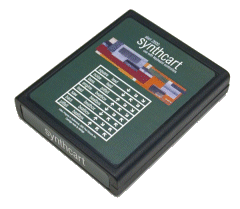 Another development that took place over time and is now making a slow emergence is musicians making music from the videogames themselves, or at least from programs made for videogame systems that would allow for the creation of music, such as the likes of Nintendo's Mario Paint for the Super NES, Codemasters' MTV Music Generator for the PC and Playstation systems, and just recently, Paul Slocum's Synthcart for the Atari 2600. Tony Fox NYC, 8 Bit Weapon, Buffy, and DesertPlanet.com are just a few of the bands and artists that have discovered how to incorporate the standard sounds of videogames into their own personal creations.
Another development that took place over time and is now making a slow emergence is musicians making music from the videogames themselves, or at least from programs made for videogame systems that would allow for the creation of music, such as the likes of Nintendo's Mario Paint for the Super NES, Codemasters' MTV Music Generator for the PC and Playstation systems, and just recently, Paul Slocum's Synthcart for the Atari 2600. Tony Fox NYC, 8 Bit Weapon, Buffy, and DesertPlanet.com are just a few of the bands and artists that have discovered how to incorporate the standard sounds of videogames into their own personal creations.
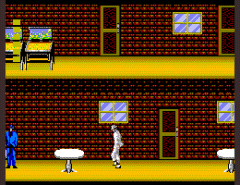 There are even games such as the
aforementioned Journey: Escape for the 2600 where the artists become the stars, however few there actually are. Of the ones I have heard about or even played, the best of the bunch would have to be Michael Jackson's Moonwalker for the Sega Genesis and Master System, which is based off his "Smooth Criminal" video-movie from the Moonwalker video feature. Before his name became such an ugly byword for child abuse, the game that featured Michael Jackson had the search and rescue of children as part of its goal while fighting off thugs and zombies with various dance moves. Even more entertaining is the "dance attack" which pauses the whole action for a bit while we see Michael and his adversaries joining together for a dance before they (not Michael) disappear off the screen. Apparently, Sega did more for this kind of game than just merely stick the likeness of Michael Jackson onto what would have been a typical platform game with some of his music, but rather translated an entire Michael Jackson video into a workable videogame experience, right down to having the stairs fold down to him at his raising a hand.
There are even games such as the
aforementioned Journey: Escape for the 2600 where the artists become the stars, however few there actually are. Of the ones I have heard about or even played, the best of the bunch would have to be Michael Jackson's Moonwalker for the Sega Genesis and Master System, which is based off his "Smooth Criminal" video-movie from the Moonwalker video feature. Before his name became such an ugly byword for child abuse, the game that featured Michael Jackson had the search and rescue of children as part of its goal while fighting off thugs and zombies with various dance moves. Even more entertaining is the "dance attack" which pauses the whole action for a bit while we see Michael and his adversaries joining together for a dance before they (not Michael) disappear off the screen. Apparently, Sega did more for this kind of game than just merely stick the likeness of Michael Jackson onto what would have been a typical platform game with some of his music, but rather translated an entire Michael Jackson video into a workable videogame experience, right down to having the stairs fold down to him at his raising a hand.
And last but not least, there are the
games where you can "play to the beat" for points. The first of such games
was Konami's Dance Dance Revolution for the Playstation, where
players attempt to follow the arrow symbols by stepping on them using the
special mat controller while staying to the beat of whatever song is being
played. This idea got tinkered around with until it became the basis for the
Guitar Hero and Rock Band series of games for the current
generation game systems, this time using a plastic guitar controller or
another kind of instrument controller in place of a mat controller. Coupled
with the use of licensed popular songs, the games made the player feel like
he was his own rock star. Karaoke Revolution and the SingStar
game series took the popular activity of karaoke to a whole new level as
gamers can now sing their way to higher points and ratings. And for those
who just prefer dancing the night away, Ubisoft's Just Dance game
series and their Michael Jackson: The Experience game for the
Nintendo Wii can make pros or fools out of their prospective audience by
letting them move their Wii Remote in the same manner as the onscreen
dancer, with ratings determined by how well the player responds to the cues.
 Eventually, videogames would begin to influence music, and then later on do the exact opposite over the years as the merging of the two entertainment mediums slowly fused together. This would begin with what I would call the "national videogame anthem", which would be the song "Pac-Man Fever", developed by two Georgia DJ's Jerry Buckner and Gary Garcia, who were fans of the Pac-Man arcade game. Released in late 1981, "Pac-Man Fever" would become a popular Top 40 radio song for several weeks, inspiring the duo to create a follow-up to the single, which would be the album version of Pac-Man Fever, featuring seven other songs based on other videogames like Asteroids, Berzerk, Centipede, Defender, Donkey Kong, Frogger, and Mousetrap. Unfortunately, the novelty of "Pac-Man Fever" wore off by the end of 1982, and the album would disappear into almost obscurity until the late 1990s, when interest in "retro-gaming" would inspire Buckner and Garcia to create an updated version of the Pac-Man Fever album, which they self-released in 1999.
Eventually, videogames would begin to influence music, and then later on do the exact opposite over the years as the merging of the two entertainment mediums slowly fused together. This would begin with what I would call the "national videogame anthem", which would be the song "Pac-Man Fever", developed by two Georgia DJ's Jerry Buckner and Gary Garcia, who were fans of the Pac-Man arcade game. Released in late 1981, "Pac-Man Fever" would become a popular Top 40 radio song for several weeks, inspiring the duo to create a follow-up to the single, which would be the album version of Pac-Man Fever, featuring seven other songs based on other videogames like Asteroids, Berzerk, Centipede, Defender, Donkey Kong, Frogger, and Mousetrap. Unfortunately, the novelty of "Pac-Man Fever" wore off by the end of 1982, and the album would disappear into almost obscurity until the late 1990s, when interest in "retro-gaming" would inspire Buckner and Garcia to create an updated version of the Pac-Man Fever album, which they self-released in 1999.
 In the meantime, videogame developers began working on translating popular tunes or composing multipart-harmonic music creations of their own to be incorporated into their games, with mixed results. Data Age, a third-party Atari 2600 software developer who sunk their own ship acquiring the license of the music band Journey for their Journey: Escape game, left their own mark with a rather weak musical loop playing the intro section of "Don't Stop Believing" with a graphical animated interpretation of the band's 1981 album cover. Activision a few years later made leaps and bounds with a rendition of Ray Parker Jr.'s theme song to the Ghostbusters movie in the Atari and Commodore personal computer versions of the game, complete with a bouncing ball over the lyrics as the song plays out on the intro screen. However, it was in the Nintendo generation of game systems when musical compositions for videogames really started to come into form, rivaling the output of what regular musicians were putting out for record shops and radio stations. At least until sometime in the 1990s, such musical compositions would only be available for listening by accessing the sound tests, if those games even had such features. Nowadays, game soundtracks can be found on compact disk and sold through various company mail-orders and specialty music shops. And through the miracle of game system emulation, they can also be "ripped" from the games themselves and played back on the computer through special programs, or even burned onto compact disks if you want to create your own soundtrack albums from games.
In the meantime, videogame developers began working on translating popular tunes or composing multipart-harmonic music creations of their own to be incorporated into their games, with mixed results. Data Age, a third-party Atari 2600 software developer who sunk their own ship acquiring the license of the music band Journey for their Journey: Escape game, left their own mark with a rather weak musical loop playing the intro section of "Don't Stop Believing" with a graphical animated interpretation of the band's 1981 album cover. Activision a few years later made leaps and bounds with a rendition of Ray Parker Jr.'s theme song to the Ghostbusters movie in the Atari and Commodore personal computer versions of the game, complete with a bouncing ball over the lyrics as the song plays out on the intro screen. However, it was in the Nintendo generation of game systems when musical compositions for videogames really started to come into form, rivaling the output of what regular musicians were putting out for record shops and radio stations. At least until sometime in the 1990s, such musical compositions would only be available for listening by accessing the sound tests, if those games even had such features. Nowadays, game soundtracks can be found on compact disk and sold through various company mail-orders and specialty music shops. And through the miracle of game system emulation, they can also be "ripped" from the games themselves and played back on the computer through special programs, or even burned onto compact disks if you want to create your own soundtrack albums from games. Another development that took place over time and is now making a slow emergence is musicians making music from the videogames themselves, or at least from programs made for videogame systems that would allow for the creation of music, such as the likes of Nintendo's Mario Paint for the Super NES, Codemasters' MTV Music Generator for the PC and Playstation systems, and just recently, Paul Slocum's Synthcart for the Atari 2600. Tony Fox NYC, 8 Bit Weapon, Buffy, and DesertPlanet.com are just a few of the bands and artists that have discovered how to incorporate the standard sounds of videogames into their own personal creations.
Another development that took place over time and is now making a slow emergence is musicians making music from the videogames themselves, or at least from programs made for videogame systems that would allow for the creation of music, such as the likes of Nintendo's Mario Paint for the Super NES, Codemasters' MTV Music Generator for the PC and Playstation systems, and just recently, Paul Slocum's Synthcart for the Atari 2600. Tony Fox NYC, 8 Bit Weapon, Buffy, and DesertPlanet.com are just a few of the bands and artists that have discovered how to incorporate the standard sounds of videogames into their own personal creations. There are even games such as the
aforementioned Journey: Escape for the 2600 where the artists become the stars, however few there actually are. Of the ones I have heard about or even played, the best of the bunch would have to be Michael Jackson's Moonwalker for the Sega Genesis and Master System, which is based off his "Smooth Criminal" video-movie from the Moonwalker video feature. Before his name became such an ugly byword for child abuse, the game that featured Michael Jackson had the search and rescue of children as part of its goal while fighting off thugs and zombies with various dance moves. Even more entertaining is the "dance attack" which pauses the whole action for a bit while we see Michael and his adversaries joining together for a dance before they (not Michael) disappear off the screen. Apparently, Sega did more for this kind of game than just merely stick the likeness of Michael Jackson onto what would have been a typical platform game with some of his music, but rather translated an entire Michael Jackson video into a workable videogame experience, right down to having the stairs fold down to him at his raising a hand.
There are even games such as the
aforementioned Journey: Escape for the 2600 where the artists become the stars, however few there actually are. Of the ones I have heard about or even played, the best of the bunch would have to be Michael Jackson's Moonwalker for the Sega Genesis and Master System, which is based off his "Smooth Criminal" video-movie from the Moonwalker video feature. Before his name became such an ugly byword for child abuse, the game that featured Michael Jackson had the search and rescue of children as part of its goal while fighting off thugs and zombies with various dance moves. Even more entertaining is the "dance attack" which pauses the whole action for a bit while we see Michael and his adversaries joining together for a dance before they (not Michael) disappear off the screen. Apparently, Sega did more for this kind of game than just merely stick the likeness of Michael Jackson onto what would have been a typical platform game with some of his music, but rather translated an entire Michael Jackson video into a workable videogame experience, right down to having the stairs fold down to him at his raising a hand.